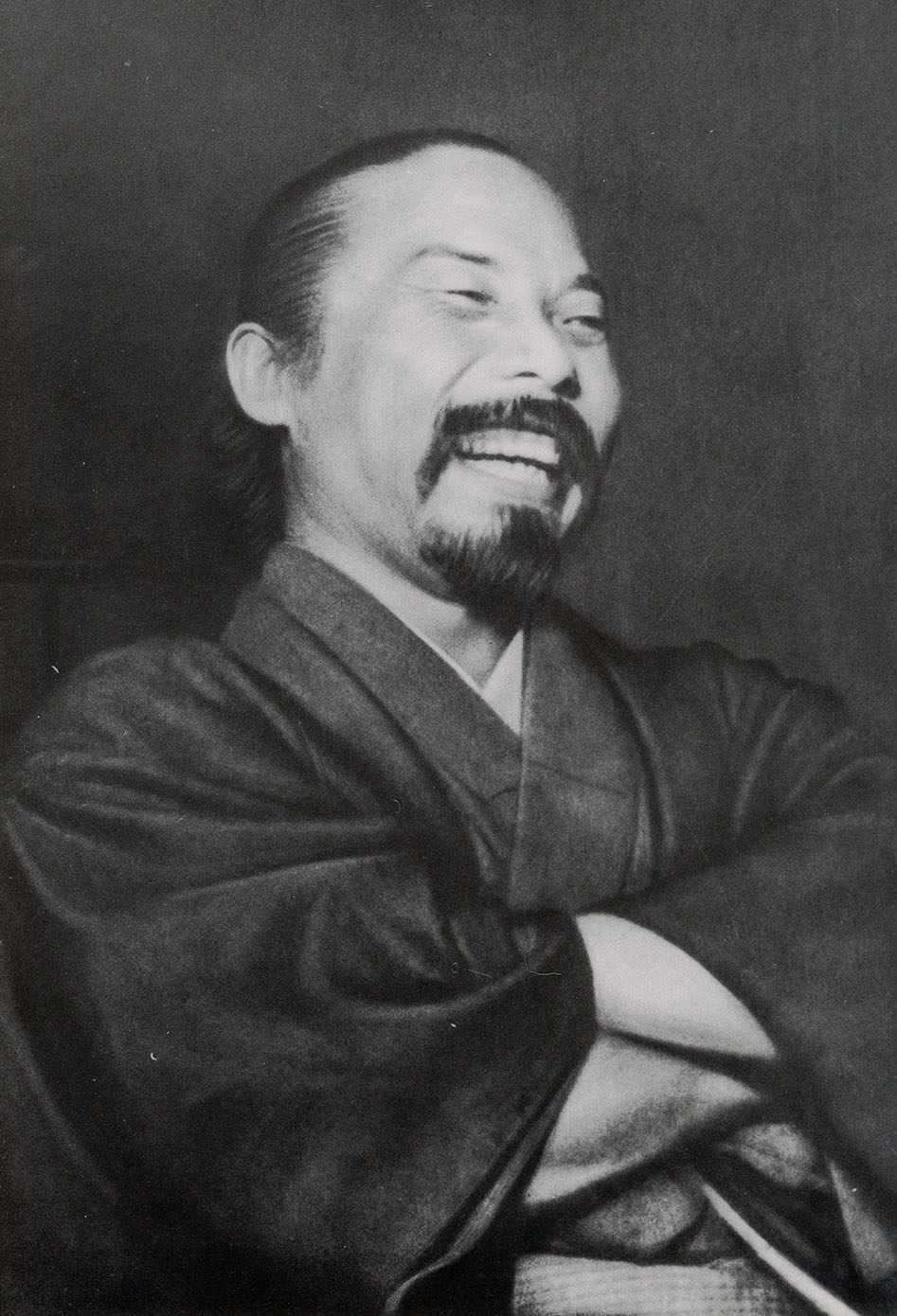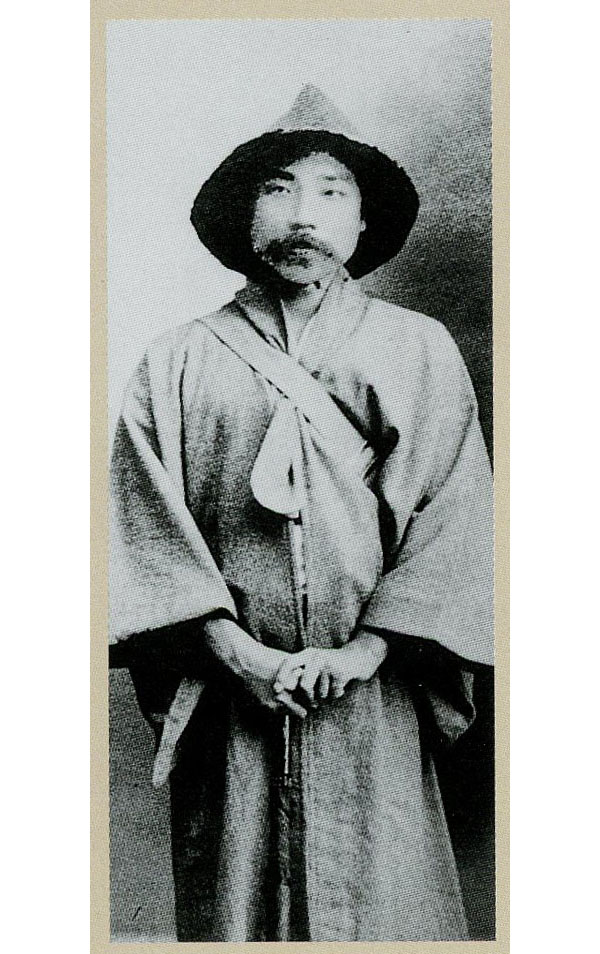
Ishii Rinkyou 作品を見る
Ishii Rinkyou was born on July 15, Meiji 17 (1884) in Shimo-owada, Tokehongou machi, Sanbu gun (currently Chiba City) as the third son to his father Jirosuke and mother Gen. They called him "Kisaburou".
The mountains behind the home of his birth were covered in woods of Japanese cedar where enormous old cedars grew. A thicket continued around the woods, resulting in a lush natural environment where Kisaburou was born and raised, and where he suffered a burn on his head at the age of two. Because of this injury he was unable to make friends, and began drawing pictures of birds and flowers on his own around four to five years old. It is said that this tiny artist was looking forward to getting gifts (picture books and paper) from his father more than anything else. There are some interesting stories about Kisaburou. Although it is unclear when this happened, an artist who was an acquaintance of his father's saw Kisaburou's drawing of a sparrow and said "This picture is magnificent. You should make this boy an artist."
He began attending a local branch school of Toke elementary school in the Meiji period 23 (1890), but disliked being asked about the burn on his head. Because he performed so well in school, he began studying at Oami higher elementary school without graduating from elementary school. Kisaburou was not athletically inclined.
When Kisaburou entered Chiba junior high school under the prewar education system in the Meiji period 30 (1897), he began receiving tutoring from art teacher Horie Masaaki. About Kisaburou at this time, Horie Masaaki said the following. "Watching him as he studied in the classroom, he seemed like someone from the countryside, but as an art teacher I saw the true light of genius in him.
He showed remarkable progress in two to three years, and was so talented that other students could not catch up."
Because of his mother Gen's death in the Meiji period 33 (1900), he quit school in his third year of junior high (some think he may have graduated) without telling any of his family members. Kisaburou made his way to Tokyo to fulfill his childhood dream of becoming an artist.
On the day of his junior high school graduation ceremony, Kisaburou's brother Youkichi learned that he went to Tokyo when he visited the dormitory. Worried, Youkichi searched for Kisaburou all around Tokyo. He finally found Kisaburou painting pictures on bowls at a china shop in Fukagawa to earn a living, but returned home without speaking to his brother.

Kisaburou aspired to paint Western-style pictures. However, he could not become familiar enough with the genre while he discovered the works of Yokoyama Taikan, Shimomura Kanzan, and Hishida Shunsou at the Japan Art Institute exhibition, and was enchanted. Kisaburou immediately sent a letter to the teachers at the institute's office, requesting an education there. Later, an acquaintance at the institute and Shimomura Kanzan introduced him to Hashimoto Gahou and he began studying under Gahou at 17 years old.
Rinkyou's first work "Shinrin" was submitted to the Hashimoto Gahou monka kenkyu kai in Meiji period 35 (1902) under the name of Ishii Kisaburou, which won the third place prize. In the same year, works such as "Shufu" and "Bijin shouyou" were submitted to a public exhibition under the name of Tenpu.(It is not certain that the name "Tenpu" was given by Gahou.)
From the Meiji period 36 (1903) to 39 (1906), he continued vigorously submitting his works to associations related to the Japan Art Institute, including the "Bijutu kensei kai", "Kouji kai", "Futaba kai", and "Hatsuka kai", winning a number of awards by their excellence that overwhelmed the efforts of all others. At that time, eight of his pieces graced the opening pages of the Japan Art Institute's official organ "Nihon Bijutsu", intoxicating readers. Rinkyou having become a favorite in the world of painters only a few years after arriving in Tokyo, submitted "Wake no Kiyomaro" to the first Bunten (Ministry of Education Art Exhibition) in the Meiji period 40 (1907). Rinkyou was held in reverence in the art world. In actuality, Rinkyou was a stubborn person with a short temper, and an undiluted, purely fervent soul. He absolutely loved debating and although he appeared bold, he was actually timid, and prone to tears.
In January, Meiji period 41 (1908), his teacher Hashimoto Gahou passed away. On the passing of his teacher, Rinkyou began walking a path of hardship.
Another blow came in August during an internal conflict among the judges at the second Bunten. At that time, Rinkyou was a director at the Kokuga gyokusei kai, and each day presented difficulties.
In the Meiji 42 (1909), it appeared that things had settled down, but it took a number of years to come to an end. During this time, Rinkyou became acquainted with Aihara Kantarou (Mokuhou), the third master of the Arai Ryokan, and heading for Shuzenji on the invitation of Kantarou to search for his own way (This can be a matter of speculation). He stayed for a long time in Shuzenji from the end of the Meiji period 40 (1907) to spring of the period 42 (1909).
Then, at the Arai ryokan, Rinkyou had an encounter that resulted in him setting out on a new path. This was his meeting with Kin, the daughter of Shigeno Umekichi, a purveyor of hats to the Imperial Household Agency behind Ginza Matsuzakaya. (Kin's mother made underclothes for the Meiji emperor on the request of the Imperial Household Agency.)
In November, Meiji period 42 (1909), he married Kin and moved to Minami Shinagawa (Goshoukyo). Finally, in December, the conflict in "Bunten" was settled, and he received an honorable mention for his submission of "Hakuei" in the Taishou period 1 (1912) at the sixth Bunten. It was a good start. However, it did not last for very long. In the Taishou period 1 (1912), the Futaba kai was adjourned indefinitely. In Taishou period 2 (1913), Kouji kai was disbanded. Tragedy again struck Rinkyou.

Wedding anniversary
At "Goshoukyo" in Minami Shinagawa, he had frequent visitors, making it impossible for him to paint during the day, so he stayed secluded in his studio on the second floor at night. The studio has the size of 12 pieces of tatami, and the adjacent room has the half size of it and a life-sized picture of Haishimoto Gahou in it. Although it is unclear who painted the picture, Rinkyou was considered constantly searching for the relationship between a master and apprentice, and perhaps this picture was evidence of this.
In the Taishou period 8 (1919), the traditional Bunten was abolished.
It was switched over to "Teiten" sponsored by the Imperial Academy of Fine Arts. The first Teiten was held from October 15 to November 20. At the Teiten, he submitted "Ryugen tendai" under the name of Rinkyou. This was a new start for Rinkyou. As a side note, Rinkyou was a heavy drinker (his father and brothers were also heavy drinkers). He often drank with his brothers Youkichi and Toranosuke. According to Iidaka Noboru, one day while drinking with his brother Toranosuke and talking about the art world, a strong wind came from behind the mountain and shook large trees in the woods, causing their branches to rattle together, and rustling the leaves. Hearing this sound brought back fond memories of his youth, which caused him to change his name to Rinkyou. (There are various explanations on the origin of his name)
Rinkyou was a devoted parent. Every summer he took his family back to his childhood home for a visit.
Rinkyou continued to occupy a difficult position in the art world. It was probably around this time where he developed a sense of nostalgia. His pieces such as "Hokora no mori to ike" and "Hayashi no naka" show the scenes of his childhood, including the mountains behind his parent's home, the gateway to Shinto sites and small shrines.
Among the visitors to Goshoukyo were the chief priest of Miyazaku Honkoku temple, who asked Rinkyou if he would like to move his studio to the large area to the side of the precincts of Honkoku temple. This area was a familiar place from his childhood.
In April, Taishou period 15 (1926), he built a new studio. The roof was covered in vermillion tiles, the walls were white, and he kept birds in the pond.
Among them were Hakkannchou, Rinkyou's most favorite birds and it was from this bird's name that he called his studio "Hakkan tei". At this studio is where he created his pieces "Satsuki" and "Two Rural Scenes."
According to neighbors, none of them saw Rinkyou drawing, but always drinking with watching the garden and wandering around the pond in his kimono. Almost no one called him Rinkyou, rather he was known as "Shinagawa no Tenpu san".
Tenpu san, at the young age of 45 left this world due to a stroke on February 25 in the Shouwa period 5 (1930), surrounded by his beloved birds.